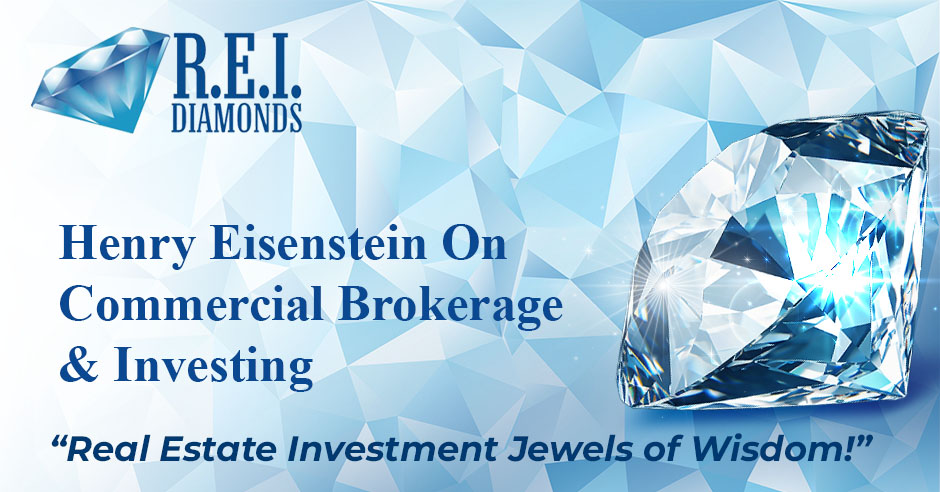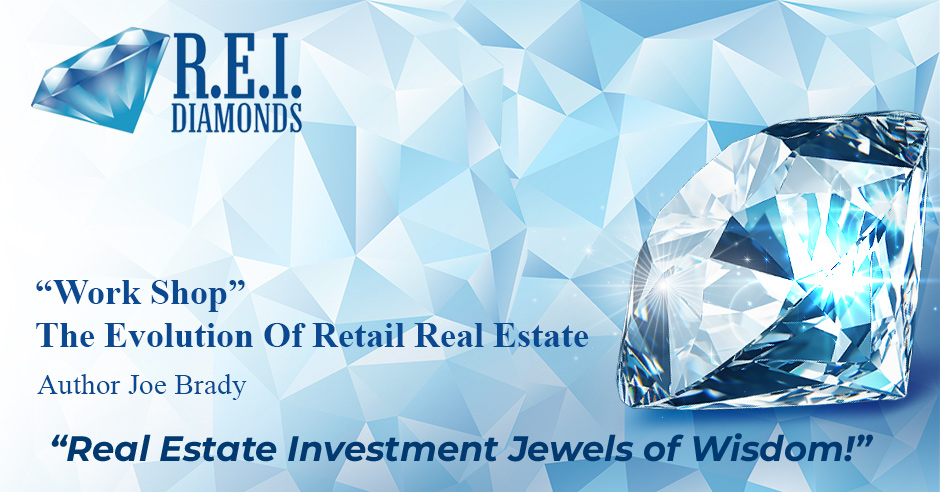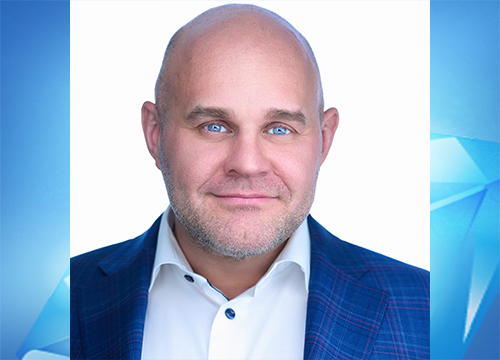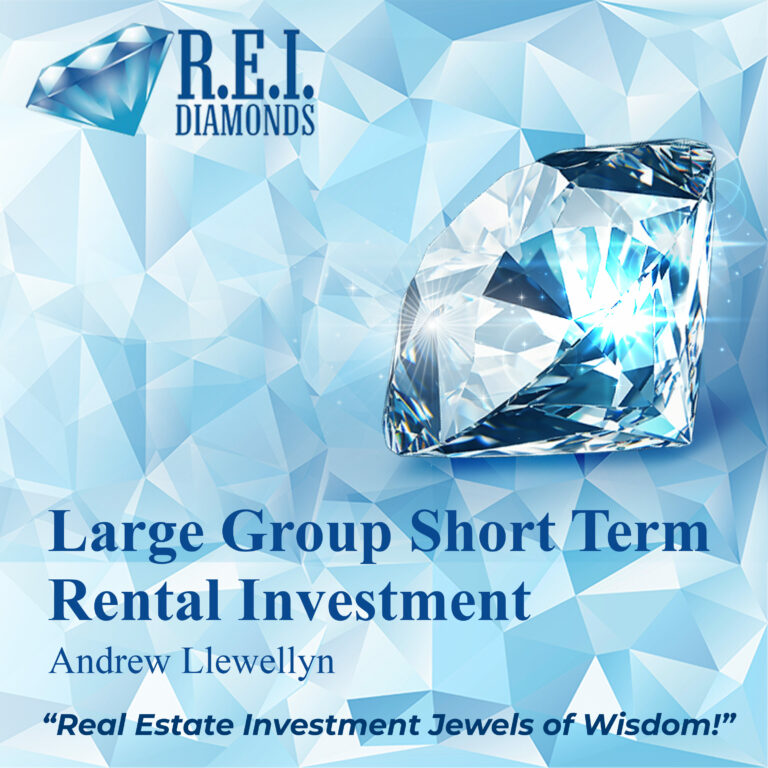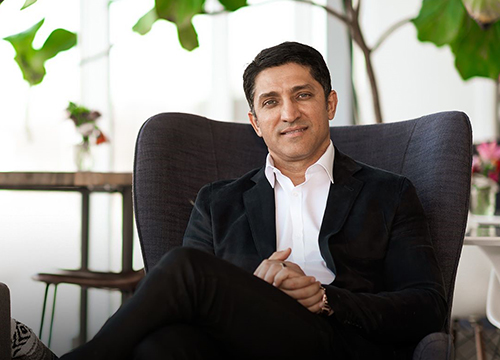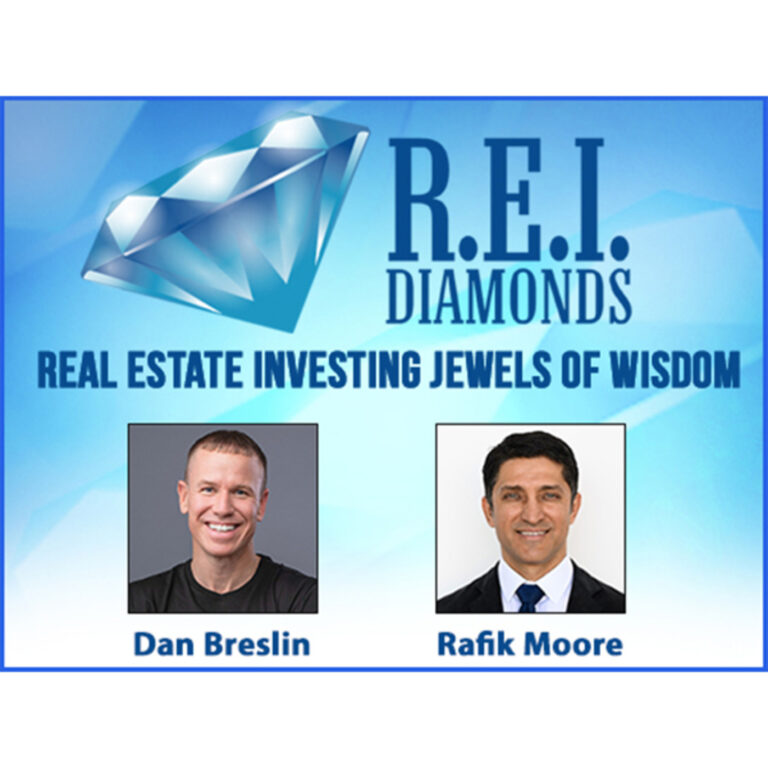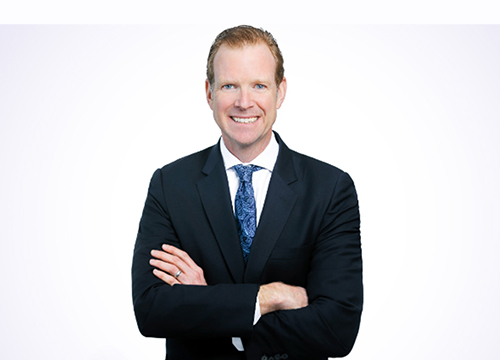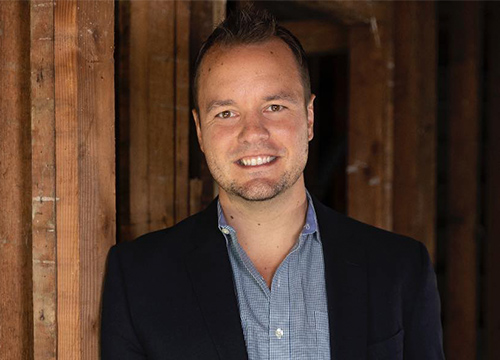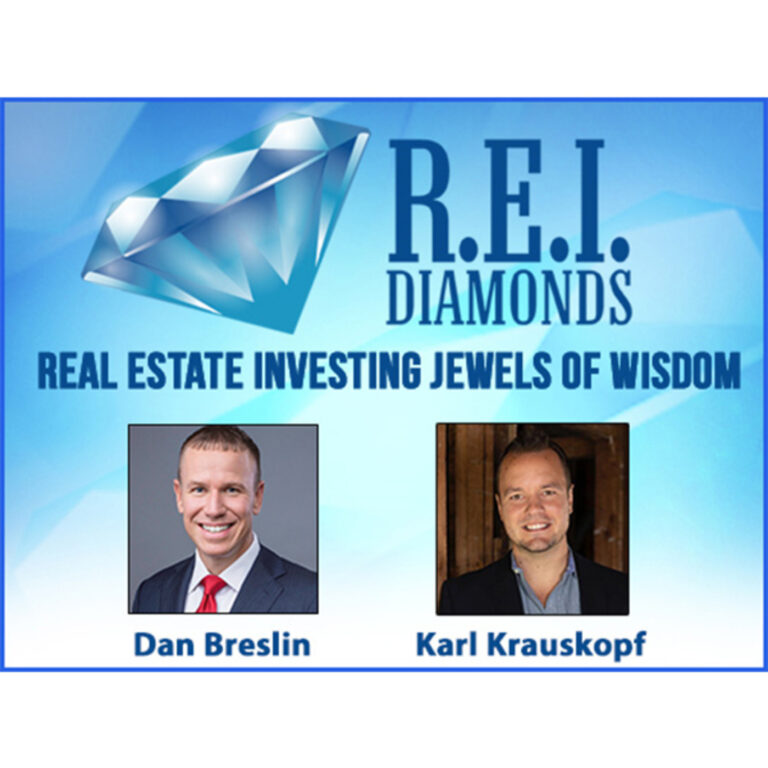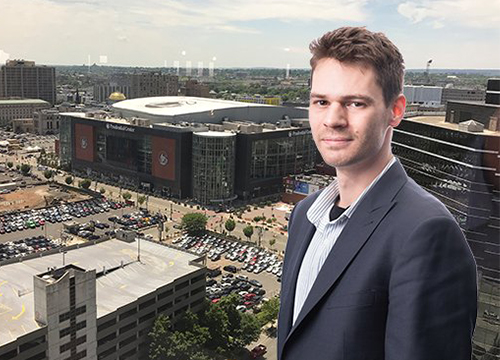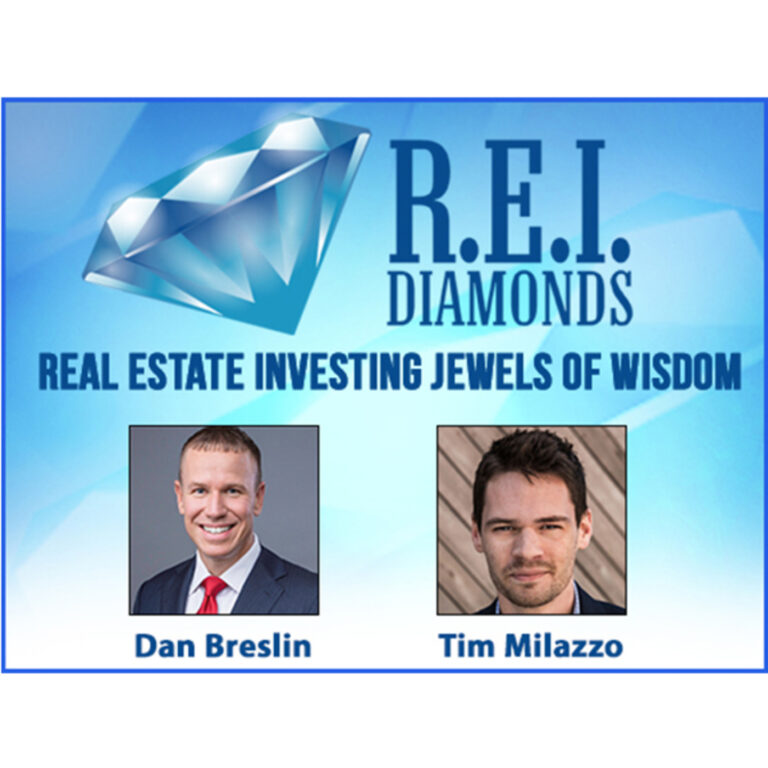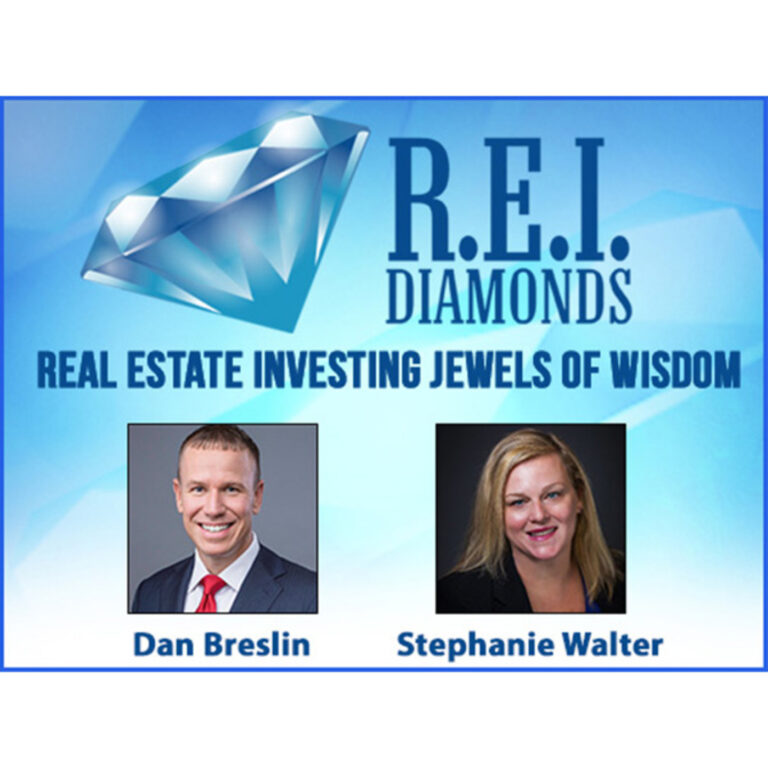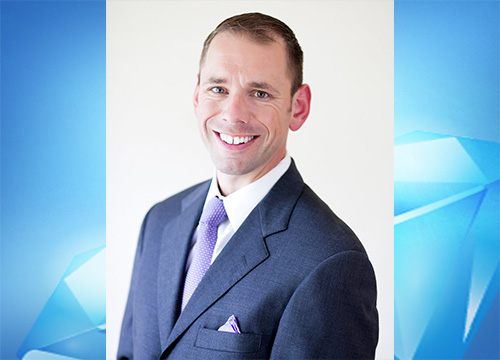Guest: Henry Eisenstein is a commercial real estate broker and investor with extensive experience in both residential and commercial transactions, with transactions rotating $650 million.
Big Idea: In the podcast, Henry and Dan Breslin discuss the importance of underwriting deals, evaluating net operating income and cap rates, and sharing personal experiences in the market. The conversation emphasizes strategic investment approaches, market analysis, and the value of collaboration in real estate.
This episode is also sponsored by Lending Home. Lending Home offers reliable & low-cost fix & flip loans with interest rates as low as 9.25%. Buy & hold loans offered even lower. Get a FREE iPad when you close your first deal by registering here now.
Resources mentioned in this episode:
Henry Eisenstein & I discuss commercial brokerage & investing:
- Importance of Understanding Market Conditions (00:00 – 00:12)
- Strategies for Underwriting Deals (02:52 – 06:00)
- Navigating Market Challenges (14:49 – 15:12)
- Collaboration in Real Estate Investing (15:27 – 18:50)
- Long-Term Investment Mindset (37:30 – 38:05)
Relevant Episodes: (200+ Content Packed Interviews in Total)
- Lane Kawaoka on Syndicating Capital for Apartment Complex Deals
- Matt Einheber on the Title Process
- REI Diamonds Show with Peter Vekselman on High Volume Investing & Retail Brokerage
- Mike Shapiro on Transforming a Southern California Real Estate Brokerage
- The iCandy Realty Fix & List Model with Steve Budzik
—
Watch the episode here
Listen to the podcast here
Henry Eisenstein On Commercial Brokerage & Investing
Mr. Henry Eisenstein, welcome to the REI Diamonds Show. How are you doing?
I’m doing amazing. How are you doing?
Also amazing. I am not in my normal Chicago studio. I’m in the corner of my room here in Florida for the winter and have yet to design a good podcast studio. Apologies to those folks who are watching the video. For those on the audio, you’ll never know the difference.
This one might be interesting. If we had the time, Henry and I are going to do some live underwriting on a deal or two later. If you circle back and watch the video, you may find that to be helpful later on. We will be posting it on our YouTube channel and probably on Henry’s too.
That’s for sure.
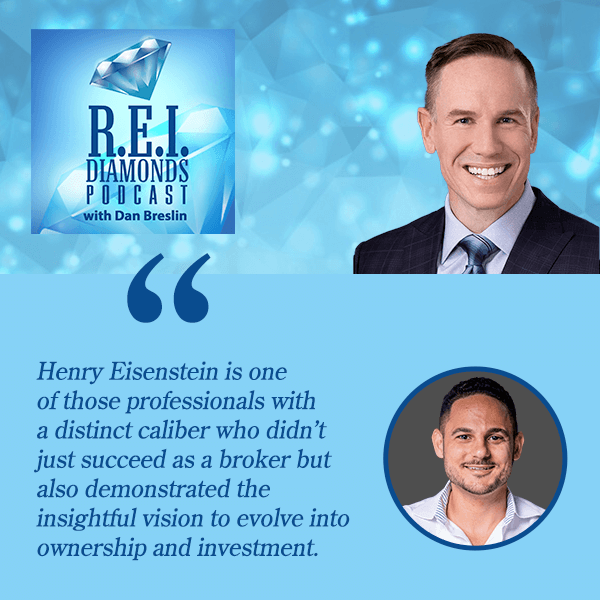
Henry, for folks who do not already know your name, do you want to give a brief intro of who you are, your history, and how you got to where you are today?
A quick two-minute spiel. My name is Henry Eisenstein. I’m a broker based out of New Jersey, now I live in Florida. I have been in the business for about ten years. I have been a part of about $650 million worth of real estate deals from small residential single-family rentals, all the way up to $20 million industrial deals and everything in between. I specialized in investment sales. I’m also an investor like Dan. I own under $10 million worth of real estate now. I’m constantly looking to build a portfolio. I also coach individuals to learn how to find deals, coach brokers on how to increase their business, and help investors find great deals all over the country. I post a lot of fun content just like Dan.
I don’t post much, but the podcast is where people can find me. I’m putting myself out there but you have to find me in the cave if you’re interested in hearing this.
I read your newsletter every Sunday.
The newsletter is good. I like the newsletter. I like writing it and people seem to also enjoy reading it. I will continue that. I appreciate your readership.
We hope so.
Henry and I are also partners with Aaron Lockhart of DEI Commercial, the Chicago division. We’re doing commercial real estate brokerage. We’re somewhat focused in the Midwest but throughout the entire country. That’s part of how Henry and I are currently doing business. We figured we come online here and talk a little bit about commercial real estate, brokerage, etc. Where should we begin, Henry?
There’s so much to talk about.
Effective Strategies For Underwriting Real Estate Deals
You said you did the brokerage first. I know a little bit about the details, just recalling from memory. A lot of people get into the business, become successful brokers, find themselves flush with some amount of cash, and think to themselves, “Why shouldn’t I invest?” I don’t know if that was some of your journey, but where was the moment when you shifted and started buying? Maybe that was different on the residential. Maybe there were two shifts, doing it on the residential, and then maybe there was another shift where things had to change in going after and owning commercial assets. Maybe we could start there.
Multiple shifts for sure. It’s a lot of little shifts versus a big epitome thing. For me, it was in the residential business where I ran a residential team, the typical residential broker type of aspect. At one point, we were doing over 100 transactions a year but a lot of it was investment sales, finding people rentals, flips, and doing some wholesale deals.
There was one deal that I watched one of my investors make $100,000 in a matter of 30 days. I think I made $4,000 or $5,000 in commission on the deal. I was like, “This guy didn’t do anything.” He used hard money. I don’t even think he put the 10% down because he had told me that he raised money from a group. He put no money down and made $100,000 in a matter of 30 days from close to close.
The property didn’t need anything. He wholetailed it, the retail version of it. I made $5,000 on the listing commission. I was like, “I clearly don’t understand the full scope of what investing is.” I feel like I did, but in that moment I felt very uneducated because if I knew, I would have been able to transact on that deal and I couldn’t.
A year and a half later, that deal came across my plate and I made like $35,000, but I did it. For the first time ever, I finally did my own wholesale deal. I had done other wholesale deals but it was always with a partner. This was the first time where I bought a deal and flipped it. It was a magical moment. I was 24 years old. I’m like, “Holy cow, I can do this.” Instead of making $5,000 or $4,000, or $7,000 in commission, I can make $35,000. I was like, “This is pretty cool. I got to learn how to do it.”
I knew enough to then take that money and move it into a four-family, which I ended up flipping. I sold that property for $35,000. That became my down payment on an FHA deal. I lived in a four-family and I was like, “I’m starting to do the investing thing.” All of a sudden, I built up to about twenty units, including a couple of single-family and a couple of multifamilies, but all still under that residential umbrella, nothing ever bigger than four units.
All of a sudden, one of my investors was like, “I’m looking for multifamilies in this area.” It was a prominent area with a lot of great deals to be had. He’s like, “I want something bigger.” I kept selling him two-family, four-family, three units, whatever. He said, “I want something bigger. If you can bring me anything up to 50 units, I’ll be interested.” I’m like, “50 units?” It blew my mind. I had never experienced doing a deal like that. My family owns a lot of retail so I always was in the leasing side of that and understood retail but I never sold anything. I only did leasing and only for a little bit.
All of a sudden, I found him a deal. It was a beat-up, a sixteen-family. It’s probably the most beat-up property I’ve ever seen in my life. Every unit was disgusting. People lived there. I couldn’t believe it. I was like, “I can’t believe this guy is about to buy it.” What happened was I negotiated this deal and I made 4% on the deal. It was closed for about $2.5 million, so I made about $100,000. I didn’t do a lot of work. I toured it maybe once and went back a second time during an inspection. Overall, the deal didn’t need me, and it closed in less than 90 days.
I was like, “Holy cow. This commercial thing is pretty cool.” I finally got a taste of the commercial side. We’ve been a part of several hundred million on the brokerage side. What hit me was about six months after that transaction, because I got hooked, I was like “I got to find more deals.”
I found this 110-family, which we can go into as much depth as you like on this one, but this was super interesting. I call up a guy and go through my spiel, “I work with a client who’s looking to buy a couple of properties in the area. I was curious if you’d be interested in selling it,” along that line. He goes, “Yeah, I’m open to selling it. When are you going to be in the area?” I’m like, “Funny enough, I’m going to be in the area later today.” I wasn’t but I lied. It was only 20 minutes away. I was like, “Let’s go”.
I got in the car and headed down there. I go meet the guy, we toured the building, got in a few units. It was another beat-up property but a wonderful location, not to maintain whatsoever, and I knew that there was some interesting value. I knew how to underwrite a property, not to the extent I do now, but kind of. We’re sitting on the porch, there’s a tenant family. I’m sitting out front with the guy, and he’s like, “What do you think it’s worth?” That’s what he said to me. He goes, “I don’t know. You make me an offer.”
At that moment, I didn’t know exactly what to say or what to do. I went with my gut and I said, “I’m probably making an offer around $1.35 million.” He goes, “I would agree to that.” I’m like, “What just happened?” I couldn’t believe what had corresponded. My response was, “Okay, great. Let me talk to my partner. I’ll get you an offer later today.” This was like 4:00. I called up a guy who I helped him sell another property for a 1031. I’m like, “I think we’re buying a property together.”
I had no idea what the game plan was but we ended up negotiating a deal where we bought this deal together 50-50. I didn’t make any commission. I rolled all my commission, which I would have made about 100% on this. I rolled 100% of my equity, so instead of upselling the cost of the property and having the seller pay a commission or whatever, we rolled all that equity into the deal. We bought it for 50-50 essentially, and I was going to manage it.
We bought it for $1.35 million. Not even 12 months later, we got an offer for $2 million in cash. We bought it. It was a wonderful deal. That deal, about 30 days after buying it, I realized at that moment that there was nothing better than what I just experienced. I need to figure out how to do this 100 times a year. It blew my mind. That was several years ago, but it was mind-blowing to experience that. It completely shifted how I look at every deal. Instead of from the realtor mindset, I’m like, “Why would I?” As a broker, I could have as easily said to him, “I think you could list this for $1.8 million.” He probably could have sold it.
Instead of looking at deals with a realtor mindset, think like an investor. That changes everything.
Instead, I told him what I would pay for it, which was a fair assessment. I thought back to my old guy with the investor where I could raise the money, I could do the deal. It doesn’t have to be my own money. We ended up buying the deal and we have over $1.25 million worth of equity in the deal now. That $80,000 to $100,000 commission check would have been cool. At the same time, it’s not worth anywhere near half a million dollars worth of equity that cashflows almost $10,000 a month.
We have something like 22 people who are deal-makers on our team. I’m big on acting as the principal. In my first deal, I acted as the principal but I was dirt broke. I was 26 years old and I made a $6,000 assignment fee. That might as well have been $20 million. It was on a $5,500 house so we’re talking about more than a 100% increase in the price.
I’ve never heard of that before. That’s pretty impressive.
Thank you. I was acting as the principal. First of all, an agent wouldn’t even take this person’s call because it was in such a rough section of town, but 6%, 10%, a $1,500 minimum commission, $3,000 commission. I came in as a principal only to be the investor mindset, always the buyer. I never ventured onto the broker side of the field to go out and broker deals.
In our business at Diamond Equity, a lot of times, we’ll have brokers try to do what we’re doing. They try to make the leap by joining the team. That can be a challenge because they’re so stuck in that habit of, “You can list it for this and then sell it for this. List it for this and then sell it for this.”
When it comes time to say those words, “I’ll give you $1.35 million,” trying to have that come out of the broker’s mouth the first time is an odd Herculean effort. Sometimes they accidentally said $1.6 million, and they had written down $1.35 million. They were supposed to say $1.35 million, and they slipped and sneezed out $1.6 million as the offer. Maybe it’s still a deal but a lot of times you put yourself over your skis and you’re out there too high on the price.
That has happened to me many times.
Me too. Probably amongst every single person on my entire team, we’ve accidentally said the too-high offer even though we had something different written down. It probably happens to the best of us. The broker has almost no risk in the deal. The principal has risk. You’re dancing a jig, you’ve got a million in equity that’s positive. You stepped in and took a calculated risk at $1.35 million. Anything could have happened. The city could have come and condemned half the building. The city could have said, “There weren’t permits for this,” and such and such. All the sewage lines could’ve been bad. There could have been a fire in there and you’re fighting the insurance company for 2 or 3 years and they don’t pay out.
There’s a very real risk in every transaction for a principal because you marry the property. The moment you take the deed, in any transaction, you’re now responsible and liable if any environmental issue were to pop up. Most people are like, “We’re buying houses, this is great. This is cool.” In the state of New Jersey especially, they thought it was a good idea to bury oil tanks for years and years. There are very real environmental risks when someone takes a deed in New Jersey. If someone didn’t know any better, they come in from California, “I’m getting a smoking deal. Look at this, $250,000..” A buried oil tank might be $50,000, $70,000, or $80,000 if it had leaked to dig out all of that dirt and then get rid of it.
The exact story has happened to me too on a flip.
The tank?
Yeah.
What would your exit cost?
We lost almost $100,000.
Do you mean you lost it, it was not a profit of $100,000?
Yeah, I’m saying we were negative on a flip by almost $100,000.
Did you know the tank was there on day one?
No.
Case in point.
Exactly. This is something that I stress to everybody when you do inspections. We didn’t end up doing it. We ended up closing in three weeks. We didn’t think about it until it was too late.
I’m in a deal now. I hope we lose $150,000. We’ll be pretty happy to lose $150,000 on that deal. The architect’s plans took forever. The city hates us because we didn’t pull the permits right. We went through three different contractors. The list goes on and on. We’re not even done with the rehab yet. We’re still working through it. We have to now finish this whole rehab so that we can lose money. If we try to sell it now without the rehab, we’re probably going to lose double the number that we’re going to lose in the end, assuming the market holds up and we get out of that deal. It’ll be a six-figure loss. The risk is real on the principal side. The broker side does not come with anywhere near that level of risk. Am I accurate there?
Understanding Risk And Wholesaling In Real Estate
I agree that most brokers have zero risk. That is a very true statement and I have felt that way in a lot of different deals. I also believe that there’s this happy medium in wholesaling that no one talks about in this brokerage world. It’s like, “Mum is the word. Don’t think about it that way. You’re a fiduciary to a client.” I’m like, “You become a fiduciary when documents are signed. I’m not your fiduciary because I called you on over the phone.” That’s not how this works.
Most brokers have zero risk. That is a very true statement.
If we sign a document saying I’m going to list your property, I then become your fiduciary. It’s not like your financial advisor is your fiduciary because you’re talking to them over the phone. That doesn’t make any sense. They can say anything that they want over the phone. It does not matter. There’s nothing signed. It’s the same thing with stock. People take it a little bit too literally.
For me, what makes the most sense? I want a win-win-win solution. The seller wins, I win, the buyer wins. How do we do that? We all make the most money possible. Everybody is happy. It’s not just about making the most money, but we do it in the cleanest fashion with the least amount of risk for me. There are instances where I’ll look at a deal where I’m like, “I want to be the broker, and I’m cool with it.”
There are other deals where I’m like, “There’s $200,000 on the bone here.” I don’t want to own this property but the spread between what the seller is willing to accept and what the buyer is willing to take, and I don’t want to buy this for whatever reason, but I can make a quick $200,000 on this, which I’m dealing with on a situation right now, I’m going to take a wholesale deal. I’ll lock this deal for $700,000 and we’re going to flip it for $900,000. I like that deal all day long. No problem. It’s in an area I probably wouldn’t buy anyway, but the spread is good.
You then have situations like this multifamily where I’m like, “$1.35 million.” I don’t even care if I’m going to flip it and make $500,000. I’d rather take down the deal and take the cashflow and hold it for equity purposes, write it all off, do a cost seg, and call it a day. Every single lens works. I feel like too many people are pigeonholed to one vertical, one way of doing business.
For me, there are a lot of ways to look at every deal. First is a principal. What would a principal do? What would a principal offer on this deal? Where would they need to be to make some money? If we can’t get it for that price, what’s next? Wholesaling. What’s the spread? Where is the seller at? What can we get a buyer at? Is there enough of a spread here where it makes sense for us to get busy?
Next, for brokers. If there’s not enough spread for us to wholesale this between A and B here, let’s go into a broker fee and maybe we’ll make 3%, 4%, 5%, or 6%. That doesn’t make any sense because the seller wants way too much money. Cool, no problem. Hands off. “Mr. Seller, would you be totally against it? We marketed the property for sale for you. We’ll see if we can try to get you some offers.” We’ll put it on the market and call it a day. Every single property fits one of those different sectors. I’m not judgmental. There’s no energy or emotion towards it. If it fits one of these boxes, we move on that. That’s it.
Thinking Bigger Lessons From Top Investors
I recently read What It Takes. Have you read What It Takes by Steve Schwarzman?
Yeah, fantastic book. His autobiography.
How about How to Make a Few Billion Dollars by Brad Jacobs?
I have that book on my night table in my bedroom.
Both of those guys had one of the same takeaways. For those who don’t know, Steve Schwarzman is the founder of Blackstone. He put that together. Sam Zell was one of his first earliest clients and they did a ton of business together.
Did he then buy his portfolio?
He wholesaled 50% of that portfolio on day one, a $19 billion double closing. I don’t think he took the deed. I think they just got assignment fees at the table to make it work. I don’t have inside knowledge on that but the way he talks about it makes it sound like they did not double close, which would have been smart because $19 billion of transfer of taxes would be an extra $1.5 billion or something throughout the country.
It’d be insane.
One of the biggest mindset shifts that occurred in there was both of them nonchalantly saying, “You just have to work on big deals.” There was no explanation. There was no doubt. There was no, “Do all this other stuff.” There was no filling in all the blanks by doing everything that came down the pike. It was like, “We’re only going to work on big deals. That’s it. Why are you going to do anything else but do a big deal?”
The way that Brad Jacobs says it in his book, which I listened to on Audible, and the way Steve Schwarzman talks about it, the billionaires are saying, “Just work on big deals.” For the shift to commercial and my own personal portfolio, to me, a big deal is something like a $2 million takedown or a $13 million self-storage development. I listen to those guys and put it into their perspective here a little bit. These are still a big deal to me though.
I’m sure there was a point when that was a big deal to them too.
I was on the phone with a broker shortly before we recorded this episode. He’s describing an illustrious career with national tenants, opening, and he had an illustrious career, exited a business, and did a bunch of things. One of them was a 30, 40-acre town center development anchored by a Target. The way he’s talking about it, he’s giving me credibility but he wasn’t the principal there. Some other guy was the builder’s principal and he helped put the tenants together. A key component there but he didn’t take the risk on the 30-acre freaking development. It’s probably, if I had to guess, a $40 million property in today’s dollars to maybe a $70 million property. I caught that the risk level wasn’t quite there.
By the way, those are two great books I’d recommend anybody take a look at, and read them front to back. I’ve reread How to Make a Few Billion Dollars so many times over. I had a training where I talked about increasing your sales price. It’s like people go, “Sure.” It’s a simplistic concept, increasing your average sales price every year, whether you’re wholesaling your average fee or your average deal size, or whether you’re brokering, or even purchasing. The simplicity of it makes sense, but how many people strategically go, “This is the plan to get us from where we are, average sale price, to here?”
I’ve done the math a thousand times. I was selling $300,000 houses about ten years ago. My average fee was like $5,000 or $6,000, 2%. I did the math then ten years ago. I remember going to a seminar where we talked about making $1 million. When you’re making $5,000 a deal to make $1 million, you’re talking about 17 transactions a month. It’s a ton of people, different types of clientele, transactions, attorneys, title companies, and emotions. It is incredibly frustrating.
We now do $85,000 a month. We do that every week right now. Sometimes it’s just one deal. Sometimes we do one deal that covers that for an entire month. I was joking around with some of my coaches. I was like, “If I could do $10 million in one deal every single year, I’d be thrilled.” It’s that level of thinking where I don’t care about doing hundreds of transactions. I’m probably going to end up doing them anyway until I find a way to do $10 million in one transaction one time a year, call it a day, and spend the rest of my time investing and spending time with my family.
It’s like that level of thinking saying, “If I was going to do $10 million in one deal, what strategic path do I have to get there? What would be my path to do that?” I’d probably have to find a deal for about $100 million, $150 million, maybe $200 million that I could sell for 5% more than I have it locked up for. You couldn’t make $10 million in one deal. It’s not overly complex.
One of my coaching students on a live call went on the phone with a guy with a $145 million deal, 700-plus units. If we locked that up and somehow got him to agree to let’s say $120 million and we found a buyer for $130 million, you make $10 million. It’s just moving zeros. It’s the same thing for a $120,000 single-family house in the middle of the XYZ area and selling it for $130 million. You find a couple of good buyers. It’s so fascinating that all of a sudden, the conversation shifts so much that the impact ends up being a thousandfold of the deals we used to do.
I guess the good question or the question I asked myself maybe a year or two ago, what am I going to say no to in order to make space for the bigger deals? We’re not going to do a flip that we can make $35,000 on. Thirty-five thousand was a flip I had been happy to do ten years ago. I’m going to have to be a little more selective. If I were starting in the business today, there’s something to be said for doing those things and earning your stripes. You have to go and buy because your bankroll is what it is, you’re buying something for $100,000, $150,000. Put in $50,000 in it, sell it for $250,000, and you walk away with $38,000 after all the interest is paid and the closing costs and all that. That’s great. It gets you started.
We see this trend too with new flippers and new investors. They first get in the business and they’re going to buy those deals. They’re easier. Maybe the construction is not as much, not as much hair on the deal in terms of the level of construction or the oil tank in the ground or whatever the case may be. Maybe it’s raising $350,000 in cash. It’s hard. There are more people that you know who could write a $150,000 or $200,000 check to cover that rehab and be a private lender than $350,000 or $400,000.
Same if you went to $700,000, $800,000, $900,000, $1 million, $2 million, and on up. There are fewer people available to do those kinds of loans. There is a place for working your way up in the numbers. I think being intentional, for me, about getting uncomfortable about participating in very large deals. It’s been three years since I’ve started to collect much larger assets myself. I think maybe I’ll focus on the uncomfortable moment.
When I bought a house, a rental property, about 8, 9, or 10 years ago, it was $55,000 I think. One of my partners wholesaled it to me and made $5,000. I was so bent out of shape about whether or not the tenant was paying. Finally, it came a moment when the guy was like, “Don’t buy it then. Either you wire the money or you don’t.” “I guess I’m wiring the money.” It felt like maybe that money was going to be gone forever and this was going to be a major problem and headache for me. The money came back. I sold it for $110,000 four or five years later. I had to evict the tenant. It was a big hassle. All the headaches I feared came true. Luckily, the market moved and I made money.
For me, if you call me and you’re like, “I need $250,000, we’re going to do this part of the deal, and this is how it’s going to work out, etc.,” I’m like, “Henry, I’m going to do it,” I’m not backing out. I never have. If I say I’m sending the $250,000, the $250,000 is coming. Even still, even though I know I’m going to do that, I have the verbal commitment to the bigger dollar amount and the bigger deal, I say I’m going to do it, and then there’s still a little internal struggle until the wire is sent off. Now that the wire is sent, there’s a sense of relief even though the deal still has to get to the profit zone. Tons of things had to happen after I sent the money.
There are those two moments there. Number one, I’m mentally and verbally committing to the deal, saying it out loud to the person whose deal I’m going in on, or even the deal I’m going to buy if it’s a deal I’m buying, and then when the wire is getting sent. That’s the two moments of commitment I noticed where I bet a lot of people would stop short of verbally committing. I know for a fact there are a lot of people who verbally commit and then don’t send the wire, which is worse.
It’s the worst feeling in the world. I have this guy, an unbelievably kind gentleman, worth upwards of half a billion dollars, a very savvy investor, who has been in the business for 50-plus years. We’ve become very close friends. We talk and we talk and he’s like a father to me, a father figure guiding me through a bunch of things, showing me all the different things. I have spreadsheets upon spreadsheets that he’s printed out and given me and like, “You could do this, this, and this.”
I never pitched him a deal but he’s always like, “Listen, if you ever find something interesting, let me know. I’m interested.” This guy, all he does is write checks all day long. I finally have a deal that I think is interesting. I’m scared to death to ask this guy for money because I’m trying to keep a good relationship because I know this guy. I want to make sure that I crush it and knock it out of the park so well, make such a great return, and hopefully, we’ll do business forever.
I have this deal. It was about a $2 million deal. I needed about $500,000 from him, maybe $600,000. I call him up. I’m like, “Listen, I have a deal, probably a 30 IRR in 18 months or less.” He’s like, “How much do you need?” I said, “$500,000,” begrudgingly, terrified to say it. It was a long pause by the way. It felt like three minutes of dead silence even though it was probably half a second. He goes, “Honestly, Henry, if I’m not writing a check for $10 million, it doesn’t make sense for me to do it.”
I’m like, “What happened?” I had such weird nerves about it. This guy could care so little about a $500,000 check. It doesn’t even make him enough money to consider writing the check. It’s these types of opportunities, these moments. When I’m speaking to these types of investors and what people are looking for, the size of the deals, take a step back and realize some people, especially when you’re talking larger numbers, you’re saying even like $50,000 wire or a $250,000 wire, every single person has their threshold.
If you’re looking for a raise or something like that, whether it’s that hesitancy or they wanted to do the deal or their desire to do the deal, I had the same feeling with the $250,000 check I invested in the deal. I was freaking terrified to send a $250,000 check about two years ago. After I did it, I think we made 25%, 23%, or something like that in six months. It was great.
It was a quick in-and-out deal. I’ve never been as terrified as sending a $250,000 check. When you talk about these massive deals, there’s such a parallel between what I have fears for. It’s the thing for realtors and investors doing their deals, the levels of risk, and everything else. It’s a wild type of business.
Overcoming Fear And Committing To Investments
I think back to What It Takes. We have to think bigger. I was on stage at the Commercial Academy that you’re going to be joining us. I’m talking about another book, which was Winning Through Intimidation. A fantastic book written by Robert Ringer. It’s a required reading for anyone in our company. I give the presentation. I’m talking about image power. I’m talking about how we did 260 deals and 300 and something last year.
I shared some of the numbers and everything. I shared whatever deals I had cooking, my 30,000-square-foot vacant warehouse, and a couple of other small warehouses. Scott, who I consider a mentor and a friend, was like, “I’m going to challenge you to step up your game and think bigger and go after higher-quality assets.” We’re putting a shovel in the ground to build our Class A storage facility. That’s the first baby step toward a higher-quality asset.
Another friend of mine from Fort Lauderdale was selling all his Class C stuff. He has like 5,000 units, owns them all individually, and he’s only focused on Class A. I’m so used to being the junk dealer where I’m finding the junker house, fixing it up, making it into something beautiful, and we’re repositioning it. I haven’t figured out how to underwrite at the top end. When you’re like, “My buddy had $500 million,” I thought what you were going to say was it was too small of a deal.
I’m thinking in my mind, another friend of mine bought a building for $30 million and owned it for like eighteen months. I don’t even think he raised the rents on the current tenants and he sold it for $60 million. If we saw that, Henry, if we were trying to underwrite that deal, I don’t even know. At 30 million, we would probably be like, “It’s just the guy’s plate.” It’s a 6.5 cap. It’s way priced out. We’re not even going to call around the brokers or anything. It’s retail junk. We’re not going to spend our time.
After you give your buddy the $15 million for him putting his money in and you take your $15 million in profit, there’s the $10 million in profit deal that we’re dreaming about. It’s still off our radar somewhat at some level because these assets are right in front of us but one person has to see what everyone else doesn’t see in order to make it happen.
I feel like a lot of people also get caught up in a metric. They get caught up in an IRR. They get caught up in the price per foot. I know I have, or a cap rate or whatever. For me, the mistake that I made until I had a recent conversation about 90 days ago with this guy where I was looking for 25 IRRs. That was my bottom line metric, being very conservative on it. The problem with that is you’re not finding enough products out there ever. I might buy a deal or two a year. I’d invest with a few friends here and there, but it was never enough to see some size.
Some people get caught up in metrics, but real estate is more than just numbers.
Now we’re on contract for almost $15 million with the real estate. I don’t have to only do 25 IRRs. I also make plenty of money for my brokerage business where I don’t even need the money today. Doing 18 to 22s or in that range, high teens for good products, and a little bit of low 20s for little bit lesser products or quality products, it’s okay. I’ll take pieces of equity along the way.
As long as I can give my investors some good rates of return, they’re thrilled. I don’t need the money today. I’ll take it when we trade in five years. It doesn’t matter. I’m building equity over time. That huge shift for me is something where that’s the difference of twenty years from today of me being a person worth $50 million versus $500 million. I only did a deal a year versus 2, 4, 5, or 8 deals. It’s overcoming that, I don’t know whether it’s fear or the hesitancy that holds you back.
Scaling Up To Higher Quality Real Estate Deals
Yeah, and we’re in a market too where from 2019 to 2022, the deals you would hear about and people would pitch were 2025 IRRs for existing products, turnaround multifamily stuff. A bunch of them sold and produced 20% and 30% IRRs, but that was a market bubble. Now, we’re in a contraction period for the last two years. This period is unlike 2008 through 2012 when there were brand new multifamily complexes trading at 30 cents on the dollar. Banking regulations have changed and they’re no longer forced to exit out of the assets the way that they were in the past crises.
The crisis buyers who are going to look like geniuses right now are the ones who are buying the Class A office buildings in the core downtown environments. They’re dropping $30 million here, $12 million there, and $8 million here. Everyone will look back and say, “Look at how smart they were. They bought and they were so contrarian against the grain.” Most of us are like, “We’re not touching an office with a 10-foot pole. You guys are nuts.”
That’s me. I feel that way.
Where else I’m going with this is I see some syndications out here where your projections are 12%, 14% IRR. The guy who bought for 30 and sold for 60 projected it like 14%, 16% on that one. That was his IRR projection on the rollout. He blew that out of the water. It was probably 80%, 90%, 100% return for his investors within eighteen months. I think that the people who know what they’re doing are not over-promising, and so they’re not putting something like 25 IRR out there unless it is a deal where that’s the risk you’re taking, a development deal or something like that.
I think that the deals people invest in now when the market is in a slump, this is like buying at the bottom. If you can find a good syndicator, a good partner, a good operator who has experience and can run a deal from start to finish. We’re doing them at the bottom right now. The interest rate environment is terrible. The tax code is terrible. Hopefully, that’s going to change here in the next 30 days. It would be great delusional optimism on my part. If some things go our way, you’re looking up in 3, 4, or 5 years, and you have 25 IRRs that you invested in thinking they were 12s, 13s, and 16s.
This is the bottom of the market when it comes to commercial real estate. We’re in it. It may last another year, two years, three years. At some point, the deals are going to turn around, but the deals that are going to turn around and pay and be the ones everyone is bragging about are the ones that people are investing in right now. Right now is a very tough time to raise money with the tax code going against us. Everyone is juiced looking for the 25 IRRs because that’s what everyone experienced in ‘21 and ‘22. Maybe a handful cashed out in ‘23. Not too many, though.
It’s interesting how in a short period of time, it completely shifts people’s perspectives. That window gave everybody such a weird perspective of where things should be, when that has not been ever a real ideology of what real estate investing has been forever, for the longest time. I don’t even know the last time other than during COVID when you saw those 20-plus IRRs. Most of the time, they were in the high teens, and people were fine with it. That was a good deal. That was a great deal. Today, because of the environment of today and everything else, I got skewed into this weird thinking that 25 is where it has to be.
To be honest, you’re making 25 before, and I’m talking before tax depreciation and appreciation of the asset, honest to God, if that’s where you’re at, it’s so rare to find. I honestly think that as time goes on for right now, maybe if you’re lucky, I don’t think I found a 25 IRR legitimately maybe more than one time in 2024. If I find more than one in 2025, I think that you’re probably not buying enough stuff. It’s so silly to me.
It’s like my guy. Real estate investing has a lot to do with luck. You can’t underwrite luck on the front end of the deal. Don’t invest your money because we’re going to get lucky in order to make a return. If someone is telling me, “It’s 12% IRR,” which I did a deal, 12% IRR on my money is what the projection is. I’m looking at the market and the long term, and we’re going to hold it for ten years. It was like a tax advantage type of deal, which is why I did it.
My delusional optimism or my luck in the back pocket is the rents are potentially going to increase more than the 2.5% that we have them at. We have a few more lots we’re going to develop in the mobile home park. Things could go our way and we might get lucky and it turns into something better. Think about the $30 million deal that turned into $60 million. Completely lucky buyer. I think it was some national who wanted their headquarters here, and bought the property. The lease was expiring and everything else, if not mistaken. I’m sure I have some of the details wrong.
By the way, it would have made it worse for us to look at it.
We would have been like, “$7 million. Not a penny more. This guy is out of his mind.”
We want 90 days of due diligence, maybe more.
Yeah, and you’ve to carry paper, 90%.
We’ll give you 10% down, and 3% interest only for 6 years.
That’s the point. You have to be in the deal in order to get lucky. Corporations are never going to come by your site unless you own a site. They’re never going to come by all your sites, so you can’t underwrite on that. Amazon moving in or Tesla across the street from your industrial property that you buy at a seven cap, it’s not happening unless you bought it at the seven cap. You have to place these pieces on the board, these bets.
It’s probably like the roulette wheel. You’re putting down enough of them and sometimes your number is going to hit and it’s going to blow all expectations out of the water. I think a lot of real estate deals that we see happen one of two ways. The guy owned it forever and bought it for free before the neighborhood gentrified. He owned it forever. He earned every freaking penny of his exit 30 years later.
By the way, he probably felt the same way we did when he bought it.
A hundred percent, like he was overpaying.
He was like, “Maybe I should have offered $50,000 less.”
He didn’t want to own it for a long time. Some people were stuck in deals. For the last ten years, you couldn’t get out of deals. There are a lot of deals you could not get out of the deal. All of a sudden, you’re in the money when COVID hits and COVID turned out with the low interest rates to be a very prominent source of luck in the market.
Navigating Market Cycles For Long-Term Success
The interesting thing about these types of times is if you can weather storms like this while competition is going out of business, going bankrupt, losing money, hand over fist sometimes, and losing relationships because of the decisions that they’ve made in the past. When you can not only survive, but thrive during these types of times, which I’m not even saying you need to do 5X the year before or anything like that, but I’m saying, small, minute increases per year.
In these types of economic circumstances, when we have another shift, which will always come because cycles are cycles, you’re going to freaking all of a sudden have a 10X return in your business, and you’re to be like, “I’m a genius.” No, it’s because you took a calculated risk during a time when most people weren’t willing to do that.
When the cycle shifts, you’re going to earn ten times your return and think you’re a genius, but really, it’s because you took calculated risks when others wouldn’t.
My mentor that I was talking about said something very interesting to me, which was, “These are the types of times when you make enough money to get by.” He made all of his money in a handful of the timing in the markets where the cycle exploded. He kept doing deals but they weren’t unbelievable. He kept doing enough deals where they made sense. He never made a killing for a long period of time during the low parts of the cycle.
He’s like, “You make enough money to get by.” All of a sudden, when the cycle shifts, he’s like, “I made $100 million in a 24-month period of time and everyone thinks I’m a genius, but I bought a lot of decent deals, and the economy finally coming the other direction.” It’s like you said, you have to be in the business to get lucky.
That’s one of my own operating principles or things I say. Do many deals. What if that deal I talk about where I’m losing that $150,000, what if that’s somebody’s first deal, Henry? They’re done. They’re out of the game. They’re out of the business. If it’s a $12,000 loss on their first deal, a lot of people are going to be done. They’re out of the business. If you’re doing many deals, you set out to do 5 or 10, you know you’re going to do many deals, and now you have enough deals to cover that loss.
The Importance Of Underwriting Deals Carefully
Hopefully, one of the other four or five you got, you get lucky on, the market moves, you get your bidding war, and you more than cover for that loss that you have on that first deal. Do many deals. Now that we’re at this segment here, do we want to maybe try our hand at underwriting a deal that might be on the market right now, Henry?
Sure, let’s do it. By the way, I’m glad we’re bringing this up. Every night, I will always look at the newest stuff. I’ll go to sort at the top, and I’ll go sort by newest, and I’ll sort by all the new stuff that came on the market. I’ll do one small one. This is completely random. I picked this one at random. There was no prior seeing this property or anything like that. This is a six-family property. I liked it because it at least had some information online that we could mess around with.
This is the new product that came on the market. You said before that you have a habit of doing this on a daily basis. Before we get into the underwriting, just so that you can keep an eye on the market, have you ever found deals here that were listed that you ended up acting on? What do you think is the takeaway? If someone built that habit, what would they be expecting from a skill to develop with that?
I do this every single night before I go to bed. I’ll take a quick look at all the newest stuff that got listed. The reason why I do it is not only for myself to keep up the skill set of practicing underwriting and always paying attention to the market. I want to know everything that hits the market. There was one time that pissed me off so much. There was a deal that closed, it was an industrial building. It wasn’t a big deal, but it was a 25,000-square-foot industrial building that was listed. It was a steal of a price because it was listed with an agent who primarily was residential. We probably could have sold it for twice what it was listed for, let’s just say it like that.
Ever since I saw that one deal, I’m like, “This will never happen again. I need to be the one to always be paying attention to these types of stuff.” Think about it, guys. We talked about a $10 million deal, you can make $1 million with $100,000. If you were only going to make $100,000 on somebody else’s mistake, which happens more than you realize, do you think it’s worth 15 minutes a day? I think so.
I’ll look these up every night. I’ll take a few of them that I like the most. I’ll send it to a few different guys and I’ll be like, “Make an offer on this at this price, these are my terms,” and we’ll try to see. I’m working on two right now. We’re not under contract but we’re negotiating. I think there’s a lot of opportunity here. This one is completely random, a newer listing property. It’s only a six-family. We’ll run some numbers. This is nothing against the broker.
This is a six-family in a decent location. I clicked on it only because I thought the price was a little high and the cap rate was a little high. I think you and I would come up with a seriously different number than what they have listed. We can always look at it from here. Six-family, gross annual current income right now is $116,000. Net operating income says $74,000. I also like that they don’t have any vacancy rate. I can’t tell what they’re including in the $22,000 operating expenses.
Why don’t we do this, Dan, for everyone here? We probably make more offers in a week than most people make in a year, so why don’t we do this? I’m going to quickly run my numbers, you quickly run yours, and let’s see who comes up with what. We got $116,000 gross. Let’s see what you come up with. Remember, it’s only six units, and this is a decent location. It’s like a B location. Decent condition. It says five two-bedroom, one-baths. This market, by the way, would trade probably around a 7.5 cap all day, maybe an 8. Good location. Not an A by any means, but probably a B market for sure. Do you have an idea of what you’re going to come at?
Yeah. I backtracked the rent to see if there was any room in the rent. With those dated units and a quick glance at Zillow, you’re talking $1,600 a month for something nicer, $1,500 a month for something like in our condition that’s a two-bed, one-bath, $1,700 for something nicer. I backed in $1,600. It was like $1,600 a month, roughly, is what they’re saying is the gross. I don’t feel like there’s a ton of room to push the rents much higher from what we’re looking at here.
What’s your NOI that you’re going to offer?
$74,000 divided by $0.08. It’s like $870,000. Divided by six, $145,000 a unit. My quick napkin math before I did that would have been like $1,600. I would have said that was the 1% rule. Maybe the top end of that range is like $160,000 a unit. Low end, $145,000. Maybe come in and start them at $135,000, $138,000 to land at $150,000-ish or so. That assumes I want to own the property.
I was going to be around the $750,000 mark to start. That would be my initial offer. But I know that I could probably sell this all day long for $900,000, $950,000. It’s $70,000 net divided into an 8 cap, $875,000. You could probably even sell it for a 7.5 today, so that would be divided by 7.5%. Probably could sell for $933,000 all day long.
This 5.5 cap deal is exactly what I was talking about at the very beginning. You can sometimes look at numbers, $1.3 million times 6% is $80,000, so the seller wants to net $1.3 million and the broker wants to make $80,000. “How did you come up with $138,000?” “I tacked on my 6% commission to what the seller said they wanted to net and that’s how we came up with it.” I find it hilarious because that happens way more often than people realize. We could be offering this person. I’ll let you make a note. Did you say $850,000 is your number?
Yeah, you need to offer them $750,000 though. The other takeaway is if you’re going to underwrite deals, it’s best to do that with two people who are going to put their cash in together and have a conversation. You and I are buying this together. We would have this conversation. You know the market better than me. Your number at $750,000, I’m always going to choose the lower number. It’s going to be pretty freaking rare that I’m like, “No, let’s go in at the $840,000 that I penciled out.”
That the magic in underwriting with multiple people involved in the deal is critical. That’s one of the reasons our company at Diamond Equity has managed to make a profit on more than we’ve lost money on. It is because more than one of us is weighing in on every single green light on a deal that we ever have. I think that investors who are working on their own to buy for their own portfolio are at a bit of a disadvantage. Hopefully, they have a husband or a wife or somebody that they can bounce the deal off of a little bit to get to the right number that works.
I would even say, I love the idea of having multiple people underwrite it. I always try to ask my agents, “Where would you make an offer if you were to make an offer?” I always like to get a gauge from them. I always like to say, “We’ll both come up with a number. Let’s go with the lowest one to start.” That always makes the most sense for sure. You can always go up. You don’t want to offer too much.
I would caution against the other person underwriting with you being the broker, even if they’re representing your side. I can’t tell you how many brokers are trying to buyer rep me. Their vested interest is in earning the commission and getting the deal to settlement, so they’re working against your interest even though they’re supposed to have a fiduciary. They’re not the ones who are going to put the commitment on the line. If the building court comes in and they have to tear down half your building or there’s an oil tank in the ground, brokers are out of the deal, and they made their money.
It’s way more helpful if it’s somebody who’s got actual cash going into the deal to put more weight on their opinion in the deal. I remember in the early days, sometimes people with less experience would advocate for, “We should pay higher. We should do this. We should do that.” They’re unaware of the risk that they’re taking on, so I’d be very cautious. You sometimes have to back down the junior partner and the experience level a little bit and help them understand all the real risks in a deal.
It’s not that Henry and I are being cheap here at $750,000. It’s not that we’re being greedy and we want to hit some colossal home run. It’s that we understand the risk that’s involved in taking the deal on. We may talk ourselves into buying this at a higher price after the negotiations going on and we took a much deeper dive in. We discover it’s a better street. The rents can be pushed higher. There may be reasons why it works at a higher number. Being cautious with someone else putting the money in the deals is a critical piece here.
As a broker, I’ve also been the person, especially because I’ve been on every side of this coin, where I don’t feel comfortable having you pay anything over X. If you want to buy this deal because the seller is only willing to sell it at X price, which I might not believe is a great deal, I want to let you know that, I’m not going to tell you to overpay. Maybe this isn’t the right deal for you.” I’ll talk myself out of the deal because it’s not about that for me. I want to make sure you don’t lose money. You will lose money if you buy your deal at X price. If you’re okay with maybe putting down more money and having a lower rate of return on investment, then okay, I can respect it, but then I want it to be very clear.
It’s not about making the deal. It’s about making sure you don’t lose money.
Analyzing A 25-Unit Multi-Family Investment Deal
This is the next one here, a 25-unit deal. A little bit larger than the six-unit we were dealing with. We’re dealing with two multifamilies. Maybe we can try something else afterward. This is a 25-unit. Let’s see if there’s any income. Twenty-five units, each apartment, a new estimated income after rental increases. Total expenses here. Total income, $513,000 a year. I like that they have a vacancy rate of 5%. Very rare to see. Let’s try to underwrite this deal real quick. This property, by the way, is probably a B market as well. The property looks like in great condition. Again, pretty similar to the last one, probably 7.5 cap all day long on market value here, especially for this size of a deal.
Is that close to New York, Red Room community in New York?
No. The last one was much closer to Manhattan, much closer to the city, but this one was much further inland. Still a good location. This type of deal here, I’m looking at this where they have only $126,000 in expenses. They have plow maintenance and water. I don’t see any repair budget whatsoever. They do have vacancies. They don’t have management. No management expense here. Obviously, for 25 units, you’re going to have management costs, whether you’re doing it yourself or not. The $513,000 a year, they have a net income of $386,000. I’m looking at a net income of probably closer to $300,000, maybe $325,000. They want a 5.6 cap. Again, $6.9 million.
In this area, let’s say your price per door divided by 25 units is $276 a door, which is an absolute insanity of a number. I would never in this market ever pay more than $200 a door. Maybe if it was all two bedrooms, I would pay $205 or $210 because you can see the price per unit, which is nice, the rents you’re getting. They’re trying to say that you can get every unit to over $2,000, get your net income up to 5.8, and have a future performa. How much do you take into consideration, Dan, the potential cap rate that we see every single freaking broker on planet Earth trying to sell us?
I don’t. I think it does help guide me. If I saw this information here and they’re $2,000 with the apartment, I’d probably go verify that I could raise the rent. Maybe if you’ve got $300 per unit without doing any of the full renovations in a low rent, that justifies a 6.5 cap on a $300,000, $310,000 of real NOI after you back out the management costs. The insurance cost is also light here. Insurance is a major issue in commercial real estate. I think $22,000 for something that probably is going to cost $5 to $6 million to replace those buildings if they had a total loss, I guess that insurance probably is going to be closer to $35,000. It’s tough to tell. You’ll find out during due diligence.
I’d say $1,400-ish a door times $25,000 to $35,000. You’re right on the money, buddy.
Yeah, that feels a little more right. A lot of times, old owners will have old insurance, so they’re underinsured. Maybe they bought this thing twenty years ago and they insured it for $2.5 million and they only have replacement value now after modest increases by the insurance company taking action at $22,720 reinsurance. They’re probably like a replacement value of $2.8, maybe $3.1 million. If that whole thing burned down, it’s going to cost $5, $6 million to rebuild it.
It’s funny that you point that out. These are the things that they don’t notice but we would notice. It’s like, “You’re only evaluating this deal at $3 million, maybe $3.5 million. You want $6.9 million but this is nowhere near the adequate insurance to have it valued at $6.9 million. This area is never going to trade at $300 a door unless it’s a brand-new construction. Asking $276 for this type of product is crazy to me. It’s nuts. I would never pay that. The $300,000, to be honest with you, I’m probably offering somewhere close to a 7.5 cap, today’s $4 million. Maybe you can stretch it to a seven at $300,000 actual true net, so $4.285, but that’s it. I believe that this will still be sitting on the market until interest rates come down to 4%. It could be a couple of years.
My number on my calculator is $3,750,000.
I guess now I’m offering more than you this time.
I probably would start there. Maybe you land at $4 million. You sign the contract. In due diligence on this deal specifically, I would ask that the insurance would be part of the due diligence package. I would say how much they had as the replacement costs on the insurance. That might be a retrade later in the deal if that was unacceptable. Some of them are coming back 150% higher. You underwrite $25,000 and it comes back at $45,000. What are you going to do with the deal? Some people are moving forward and buying them.
I know, which is an interesting point you bring up. Keep in mind that even if you miss out on a deal and they go with somebody else, the amount of people who are not only retrading but can’t get financing right now is a very interesting time. A very high likelihood that the deal might come back to you. I had a deal where the guy said he agreed to another guy’s offer. It’s the same terms, but the other guy got to him first, I guess. He took that deal, and I’m like, “No problem. I’ll match his terms if he can’t get financing.” If it comes back to me, great. I think there’s a very high likelihood that they will.
Top Book Recommendations From Henry Eisenstein
Work to follow up. This is that season where the seller and their broker are often humbled by the realities of the market. Henry, I know we’re getting to the top of our time together. I have 2 or 3 quick questions here as we close. First, we both mentioned, What It Takes and How to Make a Few Billion Dollars by Steve Schwarzman and Brad Jacobs, respectively. Are there one or two other books that you feel might be impactful for the audience to check out?
Those are some of my favorite books of all time. I think some of you haven’t read any of Tony Robbins’ books. I’ve been a huge fan of Tony for a very long time. It’s helped more of the mindset side of things. He came out with Unshakeable and even a newer book now on private equity, which I think was very interesting, as well as some of his mindset books from before. The only real books that have hit home for me other than that were Winning by Tim Grover. Great book. Relentless by Tim Grover. I think the guy who was Kobe Bryant’s coach, Michael Jordan’s coach, helped me a lot.
Where can people go to find more information about you or maybe reach out?
The best place would probably be emailing me at [email protected] or Google my name. I’m on every single platform. You can find me on YouTube. I do a ton of content. We have over 1,000 videos, everything about commercial real estate, from underwriting to lead generation to everything in between, or you can DM me on Instagram.
The Kindest Act That Changed Henry’s Life
My final question, Henry, what is the kindest thing anyone has ever done for you?
Probably the relentless love that my wife gives me. I knew she was someone different, and I’ve never had someone care so much. Even before we got married, this woman cared so much about me and my well-being. I’ve never experienced that before. I knew that from that moment on I had to marry this woman. It would be weird if I didn’t.
I could say the same thing about my wife of four months now. Henry, I appreciate your time. I got a page and a half of notes over here on the side. I appreciate you coming to the show.
Thanks so much for having me. Thank you.
Important Links
- Henry Eisenstein
- Daniel Breslin on YouTube
- Henry Eisenstein on YouTube
- Henry Eisenstein on Instagram
- [email protected]
- Diamond Equity
- What It Takes by Steve Schwarzman
- How to Make a Few Billion Dollars by Brad Jacobs
- How to Make a Few Billion Dollars on Audible
- Blackstone
- Relentless
- Winning
- Unshakeable
- Tony Robbins
- Commercial Academy
- Winning Through Intimidation
Relevant Episodes
- Lane Kawaoka on Syndicating Capital for Apartment Complex Deals
- Matt Einheber on the Title Process
- REI Diamonds Show with Peter Vekselman on High Volume Investing & Retail Brokerage
- Mike Shapiro on Transforming a Southern California Real Estate Brokerage
- The iCandy Realty Fix & List Model with Steve Budzik
About Henry Eisenstein
 Over the last 5 years, Henry’s life has exploded in every fashion. Now at 30, Henry has been a part of over $650 Million in real estate transactions, owns several investment properties, and travels the world while selling over $100 million a year personally. His life wasn’t always like this. Henry was depressed from the age of 9, and attempted suicide twice before 14 years old. Stumbled into real estate after quitting his “corporate job” he had quit college for. Went broke 3 times in real estate, and built and rebuilt his team 4 times before his break. While over the last few years, Henry went from selling over 100 single-family homes per year to now 100% focusing his time on the commercial division of his team. His next BIG goal is to take his commercial team to over $1 Billion in sales annually. He credits all of his success to 3 things. First off, his insatiable drive to be bettering himself every single day. 1% a day adds up. Secondly, he focuses on relationship building, your network is your net worth is something he truly took to heart. Lastly, living in a state of gratitude. It’s hard to have a bad day when you are overwhelmed with gratitude. This keeps him level-headed even through the toughest storms in life. Henry’s vision is to create an environment of empowerment, positivity, love, and abundance for everyone he connects with.
Over the last 5 years, Henry’s life has exploded in every fashion. Now at 30, Henry has been a part of over $650 Million in real estate transactions, owns several investment properties, and travels the world while selling over $100 million a year personally. His life wasn’t always like this. Henry was depressed from the age of 9, and attempted suicide twice before 14 years old. Stumbled into real estate after quitting his “corporate job” he had quit college for. Went broke 3 times in real estate, and built and rebuilt his team 4 times before his break. While over the last few years, Henry went from selling over 100 single-family homes per year to now 100% focusing his time on the commercial division of his team. His next BIG goal is to take his commercial team to over $1 Billion in sales annually. He credits all of his success to 3 things. First off, his insatiable drive to be bettering himself every single day. 1% a day adds up. Secondly, he focuses on relationship building, your network is your net worth is something he truly took to heart. Lastly, living in a state of gratitude. It’s hard to have a bad day when you are overwhelmed with gratitude. This keeps him level-headed even through the toughest storms in life. Henry’s vision is to create an environment of empowerment, positivity, love, and abundance for everyone he connects with.

